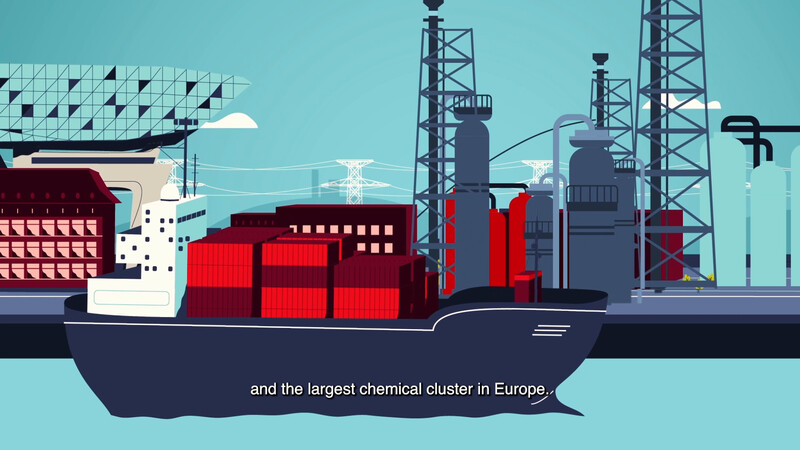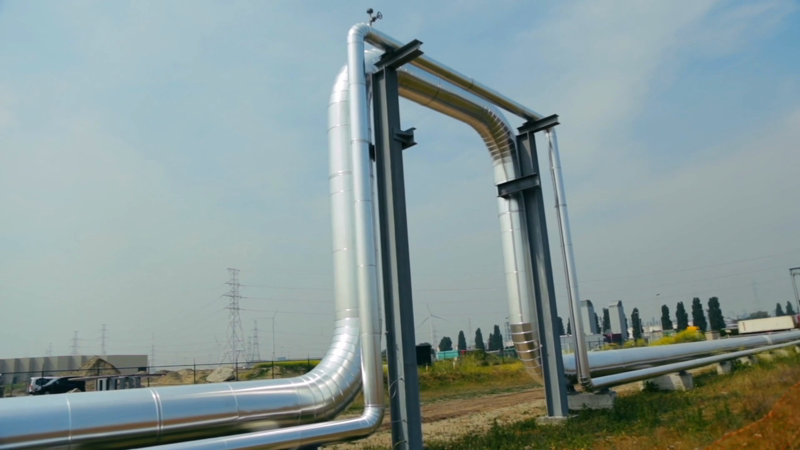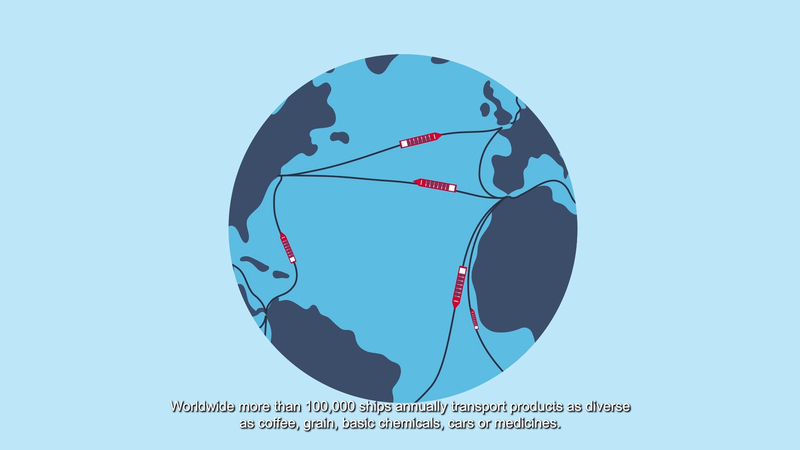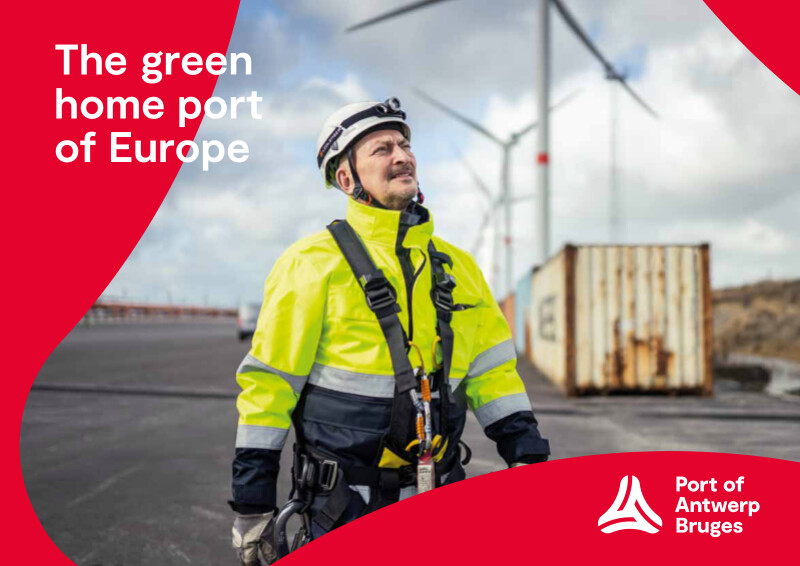Climate and energy transition
With the switch to a circular economy and major investments in the energy transition, Port of Antwerp-Bruges is aiming for climate neutrality by 2050. As a major import and export hub with a very large chemical industry, we have a range of assets at our disposal as a port to limit the impact on the climate.

Almost all activities in industry or shipping are based on fossil energy and raw materials today. Unfortunately, it is those fossil fuels and the accompanying CO₂ emissions that are causing the climate problem.
Precisely because Port of Antwerp-Bruges has an extensive ecosystem of industrial and logistical companies and the right know-how as to chemical processes, logistics, operations and infrastructure, it is the ideal hub for alternative energy flows. By making a full commitment to efficiency and circularity and switching to renewable sources and raw materials, we are making the move towards a climate-neutral economy.
Green energy hub
As the world evolves, we evolve too. With maritime connections to more than 1000 ports, Port of Antwerp-Bruges is at the heart of international world trade.
It is our ambition, as an active pioneer of the sustainable hydrogen economy, to become Europe's leading import hub for green hydrogen.


More efficient use of raw materials
As an energy hub, Port of Antwerp-Bruges is the place where the energy transition is taking shape. By reducing the requirement for energy and raw materials or approaching them more efficiently, we are already making significant progress for the climate. For example, this may be through using residual flows from industry, such as heat or CO₂, as raw materials elsewhere.
Antwerp-North Heat Network and Ecluse: Reusing residual heat
Antwerp is the home port for the largest chemical cluster in Europe. This produces an awful lot of heat. Port of Antwerp-Bruges is aiming to limit the loss of industrial residual heat by using it elsewhere.
We are researching a range of concepts for using industrial residual heat commercially and supplying it to buildings in the city and the port. We are doing this collaboration with industry, the government and other social actors in the Antwerp-North Heat Network project.
ECLUSE supplies residual heat to surrounding port companies via a steam network. The heat from six incineration plants is reused in industrial processes, and serves to heat buildings.
In the long run, 100,000 fewer tons of CO₂ will be emitted each year.

NextGen District: hotspot for the circular economy
The NextGen District in Antwerp is an incubator for innovative, sustainable and circular chemistry. The former Opel site, occupying approximately 88 hectares, will therefore be given a new purpose as the new hub for the circular economy.
Antwerp@C: reusing CO₂
Air Liquide, BASF, Borealis, ExxonMobil, INEOS, Fluxys, Port of Antwerp-Bruges and Total are joining together to investigate Carbon Capture Utilisation & Storage (CCUS) in Antwerp@C . The aim of this project is to capture half of the CO₂ emissions at the port with CCUS by 2030.

If this infrastructure can be realised, it will benefit the industrial port community and make a valuable contribution to the Flemish, Belgian and European climate objectives.

Local renewable energy
As an energy and industry hub, we consume a great deal of energy. The port companies produce a great deal of renewable energy locally with solar panels and wind turbines.
The wind turbines at the port generate power for terminals, ships and local residents in an environmentally friendly way, without burning fossil fuels.

Wind turbines often supply the locally generated energy directly to businesses.

Today there are already many wind turbines in our port and they make an important contribution to green energy.
Zeebrugge
- 50 wind turbines
- 130 MW capacity
- 90,000 families
Antwerp
- 80 wind turbines
- 200 MW capacity
- 140,000 families
The solar park at ADPO in Kallo is a special solar-powered technology. The mirrors generate green heat based on concentrated sunlight. A first for Europe!

Import and production of hydrogen from renewable energy
Climate change is a global problem, so it cannot only be tackled locally. As a world port, we want to contribute to a climate-neutral European economy by committing to the hydrogen economy. In a hydrogen economy, hydrogen gas is used as an energy carrier or as a raw material during a production process.
We do so with producing our own green hydrogen, as well as by importing hydrogen.
HyoffWind hydrogen plant
Zeebrugge is the ideal location for a green hydrogen plant. It is the place where the energy from the offshore wind turbines comes ashore and the home base for state-of-the-art LNG infrastructure.This is why Fluxys and Eoly are planning to build a green hydrogen plant there: HyoffWind. This is set to produce the first green hydrogen in 2025.

In Northwest Europe, it is impossible to generate all the required energy locally from renewable sources. As such, highly concrete plans are on the table to import hydrogen, produced with green energy from countries where there is abundant sun.
The hydrogen modules are transported via pipelines or by ship to Port of Antwerp-Bruges. However, they do need to be bonded with a hydrogen carrier such as ammonia or methanol first. At the port, this is reconverted back to pure hydrogen, which can be used as a raw material or fuel. The imported hydrogen carriers, such as ammonia and methanol, can serve as green fuel for ships and aeroplane, for generating heat or as a raw material for chemistry. There is still a long way to go here, but it is the route we are continuing to work on.
DEME, Engie, Exmar, Fluxys, Port of Antwerp-Bruges and WaterstofNet, as industrial players and public stakeholders, are bringing their expertise together in the hydrogen coalition. Together, we are throwing our weight behind practical projects for shaping the production, transport and storage of hydrogen.
Cleaner sea and inland navigation
Multi Fuel Port: alternative fuel offerings
Over 90% of the world's trade goes via sea and this requires colossal amounts of fuel. On 1 January 2020, the International Maritime Organisation (IMO) decided that the sulphur content in marine fuels worldwide must not exceed the 0.5% threshold. Consequently, sales of clean marine fuels (Ultra Low Sulphur Fuel Oil) are on the rise.
Antwerp and Zeebrugge are in an even more strictly controlled emission control area. This means that ships running on conventional fuels such as bunker oil must now run on fuel that contains a maximum of 0.1% sulphur. These regulations have also driven the demand for alternative fuels such as LNG.
LNG (Liquified Natural Gas)
LNG is the perfect leg up to the use of alternative low-carbon fuels. It causes fewer emissions than bunker oil, is relatively easy to obtain and it is operationally and financially viable to outfit ships with an LNG engine.
Zeebrugge is the gateway for the supply of LNG in North-West Europe. The facility is designed for loading and unloading ships carrying LNG. Fluxys temporarily stores the LNG supplied in buffer tanks there and regasifies it for transport via pipelines, LNGtrucks or aboard other LNG ships.
In Antwerp, the LNG Flexfueler takes care of bunkering.

Shore power for sea and inland navigation
Shore power allows ships ashore to shut down their engines or generator and connect to the grid. This reduces emissions of nitrogen oxides, sulphur oxides, CO₂ and particulate matter), improves air quality and reduces noisepollution. It is also better for the ship's engine. Where shore power is available, it is prohibited to use the generator.
Barges have been able to connect to shore power when berthed for several years now. Not that many seagoing vessels are yet equipped for shore power. Substantial technical facilities are required for it, both on board the ship and on the quay.
So by offering shore power for seagoing vessels, we want to break the 'chicken or egg' situation. That's why we are working on rolling out shore power for seagoing vessels in the near future.

Greening of our own fleet
Port of Antwerp-Bruges has its own fleet of tugs, dredgers and enforcement vessels. We are investing heavily in the integration of alternative fuels into this fleet and connect every ship to shore power where possible. We are reducing energy consumption by operating the existing fleet at lower revs.
In addition, we are systematically replacing the fleet with a more economical and environmentally friendly type of vessel. For example, we have ongoing projects with hydrogen and methanol-powered tugs. The new enforcement vessels can also run fully electric, hybrid or on diesel.
Hydrotug: the first hydrogen-powered tug in the world
The hydrogen-powered tug is a world first.The internal combustion engines that drive this ‘Hydrotug’ run on hydrogen in combination with diesel and comply with the most stringent standard, the EU Stage V, making them the most emission-efficient engines on the market.

Two hybrid enforcement vessels
The enforcement vessels are equipped with a battery pack, meaning the vessels can run on electricity alone at 9kph for 2.5 hours. They can also run hybrid or on diesel, as the situation requires. This unique system reduces fuel consumption and ensures minimal CO₂ emissions. The integrated exhaust gas treatment and soot filter also release fewer harmful sulphur and nitrogen oxides.








